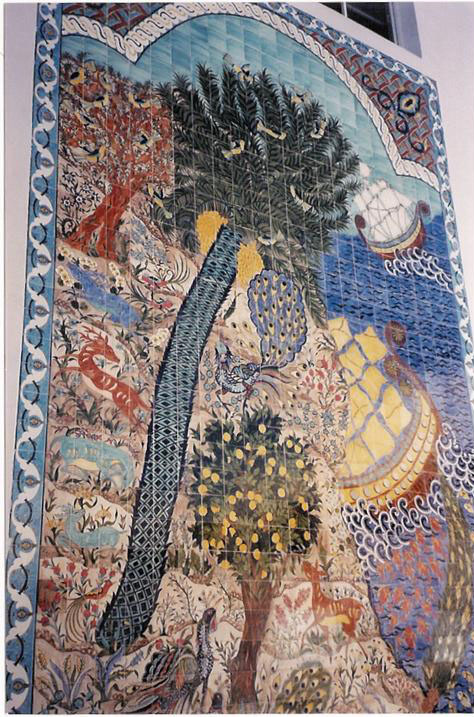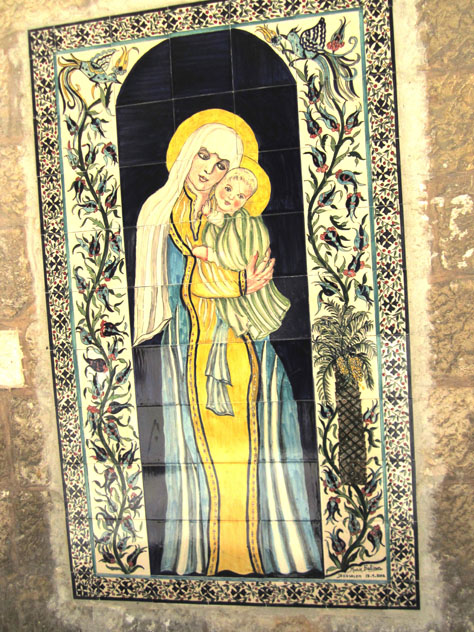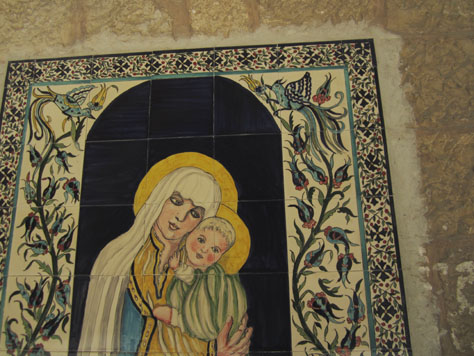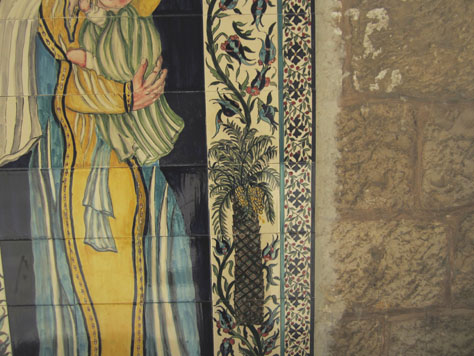| Balian Wall, Jerusalem

Marie Balian- the Virgin Mary, Court of Saint James Cathedral, Armenian Quarter Jerusalem 2012



On Marie Balian's Madonna and Jesus in her arms
|
"A Glimpse of Paradise"
Nurith Kenaan-Kedar
The unique mural "A Glimpse of Paradise" by the Armenian artist
Marie Balian, installed on Koresh St., Jerusalem, was presented
in the year 2004 as a gift to the city in which she has been living and
working for the past forty years.
The “Glimpse of Paradise” mural by Marie Balian is monumental in
size (4 x 6 m.), and composed of one thousand tiles. The wall is
exceptional within the traditions of urban murals and wall paintings of
the 20th century. The artist does not conduct a dialogue with the
traditions of historical murals and wall paintings, such
as in Mexico City, or with the murals of social protest
known from the city of Los Angeles; nor does she relate to the various
other murals that decorate the city of Jerusalem, depicting scenes
from its everyday life in the different neighborhoods, and
painted by the celebrated workshops of the city of Lyon in
France. Rather, Marie Balian’s monumental wall depicts a visionary
panoramic landscape offering a “glimpse of paradise”
that differs in intent from those other murals that depict
national history, everyday life, and protest.
Marie Balian's work forms a major chapter in the art history of
Armenian ceramics in Jerusalem, as an individual inventive art created
within an ancient formal tradition. The dialogue conducted by the
artist with this tradition has resulted in a vibrant work with a
unique language, reflecting a magical and idyllic world, one that is
dynamic, personal and feminine.
The arrival of the Armenian ceramics artists in Jerusalem
constitutes a fascinating chapter in the history of the city. In 1918,
the Armenian artist David Ohannessian was invited to Jerusalem to
restore and renovate the tiles of the Dome of the Rock. Joining
the ancient Armenian community of Jerusalem and investigating its
complex pictorial traditions, the Ohannessian, Balian, and Karakashian
families then chose to remain in the city, despite the Dome of the Rock
project soon being abandoned.
In 1922 the painter Megherdich Karkashian, and the potter Neshan
Balian with his students and co-workers, left the Ohanessian
workshop and opened their own workshops. In their works and
the works of their sons a unique formal lexicon emerged, on the
one hand preserving the traditional Iznik and Kutaya vocabulary
of forms they had brought with them, and on the other hand
incorporating new motifs indigenous to the Holy Land, such as
Early Christian images, familiar from mosaics in the Holy Land
and Jordan, in which the 6th-century Armenian mosaic dedicated
to the unknown Armenian soldier who had served in the Roman
Legions provided a major source of inspiration. Their works also
included images adopted from the mosaic floor at the Hisham palace in
Jericho. Their unique language reflects the world of these artists as
Christian-Armenians and Jerusalemites, and all of them have contributed
large murals to the city of Jerusalem.
The three generations of Armenian artists have created
numerous and important monumental works for a variety of Christian,
Muslim and Jewish urban institutions in Jerusalem, from the
decoration of the Armenian churches in Jerusalem and the
Patriarchs' sepulchral gallery in the Armenian cemetery, to museums,
religious shrines, and hospitals. At the same time their production of
Armenian ceramic decorations and ceramic wares established a
norm of local aesthetics in private homes. In addition, Ora
Herzog, the wife of Chaim Herzog, the then President of
Israel, commissioned Marie Balian to create three imaginative
panels for the official residence of the Presidents of Israel.
The process of creating "A Glimpse of Paradise" took six full
months and required meticulous execution as well as vision and
ingenuity. The tiles were designed and painted by Marie Balian herself
in the family workshop, with no help from assistant artisans and under
difficult conditions. Her strong desire to give to the citizens of
Jerusalem a work of beauty, joy and hope, helped her overcome the
difficulties. The artist began work by carefully outlining the entire
composition on the tiles using charcoal. Each individual tile was then
designed and painted separately. Next, the tiles were fired in the kiln
and, finally, positioned according to the overall design,
forming the complete oeuvre.
The mural presents a cosmic, idyllic panorama independent of the
vibrant urban reality surrounding it – unlike other murals in
Jerusalem. Land and sea are united in an undulating diagonal line that
crosses the entire piece, framed by two images of trees: a date palm
and a cypress, accompanied by lemon and pomegranate trees, flowers and
other plants. Gazelles roam in the meadow, and birds nest in the trees.
At the bottom of the mural are two peacocks, their tails spread; the
tail of a third peacock serves as the focal point of the picture. In
the sea, next to two ancient ships, there are flying fish. The trunk of
the date palm towers diagonally from the land and its fronds spread
over the water, while the long shadow cast by the cypress curves against
the sea and is framed by its blue hues. The cypress and date
palm are traditionally represented as symbols of life and eternity.
They are commonly found in Early Christian art and in Islamic painting,
as imposing iconic components that constitute a complex landscape in
itself. Unlike those traditions, however, in which the trees are
represented as motionless, Marie Balian has constructed a composition
in constant motion, through the use of rounded forms, an undulating
line, and transitions to geometric patterns, alongside the free-form
depiction of a floral landscape.
Central images that feature in Balian's other works are
intensified here and assigned multi-layered meanings, while new
motifs are added. Among these are the symbolic ship in the sea,
signifying the journey of man; the fruit trees accompanying the
palm and cypress, depicted as mythical entities; mythical flowers; the
peacocks, whose tails resemble an elegant gown, are Christian symbols
of Paradise and already featured in Early Christian art; and
gazelles symbolizing the souls of the believers, as in the
Early Christian mosaics of Ravenna, Rome and the Holy Land,
coming to drink at a water source - a symbolic image of
Christ. Marie Balian has given all these images new lives –
and a huge surface – while subjecting them to her own universe.
. In the 1960s,
Marie Balian, then a mother of three, became the leading painter of the
Balian workshop. Her first works were faithful to the existing
traditional repertoire, but she soon began developing her own lexicon
of forms. A critical dialogue with tradition is evident even in her
earlier works, as is the development of a rich and varied repertory,
incorporating forms of symbolic and allegorical significance.
Marie Balian's tile panels of the 1980s (displayed in the Israeli
President’s official residence) and the 1990s, represent a consolidated
stage of her work. The sources of the forms used are varied and can be
traced to numerous pictorial traditions. The composition of the panels
includes elements such as trees, flowers, animals and abstract shapes,
not related logically to each other; but, rather, linked on a
symbolic level and together representing Balian's idyllic
and narrative world, her transcendental reality. Her style is evident
in the quick, undulating lines and in the frequent contact between the
outlines of the various elements in the painting, forming a dynamic,
independent network. The events depicted in the panels are
simultaneous, forming a lively and dynamic picture.
Relating to her art Marie Balian said :"Objects in nature
are not straight, they are all rounded and twisted, as is the tree and
its trunk as the movement of man and water. I see the world in motion
and round. The circle as harmonious and its and its movement as ab
expression of absolute beauty."
In its physical reality the tiled wall "A Glimpse of Paradise"
absorbs and reflects light Its symbolical essence is of
promise and hope. Thus its presence creates a double
layered reality of a a mysterious paradeis in the the urban scene
of the city of Jerusalem. |